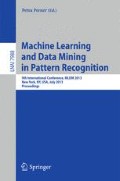Abstract
A machine learning model is said overfit the training data relative to a simpler model if the first model is more accurate on the training data but less accurate on the test data. Overfitting control—selecting an appropriate complexity fit—is a central problem in machine learning. Previous overfitting control methods include penalty methods, which penalize a model for complexity, cross-validation methods, which experimentally determine when overfitting occurs on the training data relative to the test data, and ensemble methods, which reduce overfitting risk by combining multiple models. These methods are all eager in that they attempt to control overfitting at training time, and they all attempt to improve the average accuracy, as computed over the test data. This paper presents an overfitting control method which is lazy—it attempts to control overfitting at prediction time for each test case. Our results suggest that lazy methods perform well because they exploit the particulars of each test case at prediction time rather than averaging over all possible test cases at training time.
Access this chapter
Tax calculation will be finalised at checkout
Purchases are for personal use only
Preview
Unable to display preview. Download preview PDF.
References
Borra, S., Di Ciaccio, A.: Measuring the prediction error. A comparison of cross-validation, bootstrap and covariance penalty methods. Computational Statistics & Data Analysis 54(12), 2976–2989 (2010)
Ng, A.Y.: Preventing ‘overfitting’ of cross-validation data. In: Fourteenth International Conference on Machine Learning (Workshop), pp. 245–253. Morgan Kaufmann (1997)
Krogh, P.S.A.: Learning with ensembles: How over-fitting can be useful. In: Advances in Neural Information Processing Systems 8: Proceedings of the 1995 Conference, vol. 8, p. 190. MIT Press (1996)
Esposito, F., Malerba, D., Semeraro, G., Kay, J.: A comparative analysis of methods for pruning decision trees. IEEE Transactions on Pattern Analysis and Machine Intelligence 19(5), 476–491 (1997)
Mehta, M., Rissanen, J., Agrawal, R.: MDL-based decision tree pruning. In: Proc. 1st Intl. Conf. Knowledge Discovery and Data Mining, KDD 1995, Montreal, Canada (1995)
Hinton, G.E., Van Camp, D.: Keeping the neural networks simple by minimizing the description length of the weights. In: Proceedings of the Sixth Annual Conference on Computational Learning Theory, pp. 5–13. ACM (1993)
Lawrence, S., Giles, C.L.: Overfitting and neural networks: Conjugate gradient and back-propagation. In: Proceedings of the IEEE-INNS-ENNS International Joint Conference on Neural Networks, IJCNN 2000, vol. 1, pp. 114–119. IEEE (2000)
Castellano, G., Fanelli, A.M., Pelillo, M.: An empirical comparison of node pruning methods for layered feed-forward neural networks. In: Proceedings of 1993 International Joint Conference on Neural Networks, IJCNN 1993, Nagoya, vol. 1, pp. 321–326. IEEE (1993)
Reed, R.: Pruning algorithms-a survey. IEEE Transactions on Neural Networks 4(5), 740–747 (1993)
Chapelle, O., Vapnik, V., Bousquet, O., Mukherjee, S.: Choosing multiple parameters for support vector machines. Machine Learning 46(1), 131–159 (2002)
Kearns, M.: A bound on the error of cross validation using the approximation and estimation rates, with consequences for the training-test split. Neural Computation 9(5), 1143–1161 (1997)
Samet, H.: Foundations of Multidimensional and Metric Data Structures. Morgan Kaufmann (2006)
Moore, A., Schneider, J., et al.: Efficient Locally Weighted Polynomial Regression Predictions. In: Fourteenth International Conference on Machine Learning. Morgan Kaufmann (1997)
Garcia, E.K., Feldman, S., Gupta, M.R., Srivastava, S.: Completely lazy learning. IEEE Transactions on Knowledge and Data Engineering 22(9), 1274–1285 (2010)
Friedman, J.H., Kohavi, R., Yun, Y.: Lazy decision trees. In: Proceedings of the National Conference on Artificial Intelligence, pp. 717–724 (1996)
Author information
Authors and Affiliations
Editor information
Editors and Affiliations
Rights and permissions
Copyright information
© 2013 Springer-Verlag Berlin Heidelberg
About this paper
Cite this paper
Prieditis, A., Sapp, S. (2013). Lazy Overfitting Control. In: Perner, P. (eds) Machine Learning and Data Mining in Pattern Recognition. MLDM 2013. Lecture Notes in Computer Science(), vol 7988. Springer, Berlin, Heidelberg. https://doi.org/10.1007/978-3-642-39712-7_37
Download citation
DOI: https://doi.org/10.1007/978-3-642-39712-7_37
Publisher Name: Springer, Berlin, Heidelberg
Print ISBN: 978-3-642-39711-0
Online ISBN: 978-3-642-39712-7
eBook Packages: Computer ScienceComputer Science (R0)

